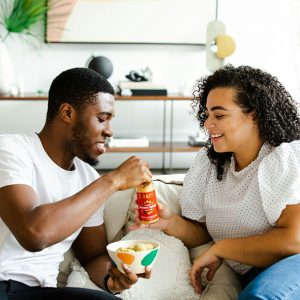When most people think of disability they think of a visible physical impairment. They think of someone using a wheelchair or a scooter to move around, or someone with a white cane to navigate their environment. Many of us, disabled and non-disabled, don’t realize that disability has many meanings and refers to many experiences.
As a sexual health educator one of the most common questions about sex and disability I get from people who are non-disabled is, “How do you have sex if you can’t move X“. X might be “your hands” or “your legs” or “your whole body“. But whatever it is, the question is about how to engage in sexual activity with some sort of mobility impairment.
One of the questions I get asked a lot by people who live with disabilities is, “How can I have sex if I can’t get into the right position?“
These are the things most people think of when they think about sex and disability. Things like:
- Being unable to physically stimulate yourself or a partner as you want to
- Being unable to get into particular positions
- Not being able to monitor or control your own body responses (like losing bowel or bladder control during sex)
There is no question that these are barriers to sexual expression. But what most people don’t realize is that these can be among the most straightforward barriers to address. This won’t always be true, but the reason it is for most of us is because physical barriers, once identified, are concrete. Other barriers – like finding partners, figuring out your own sexual desires and identities, working through experiences of violence and discrimination – are more complicated and involve the rest of the world. If you have a partner who wants to have sex or you want to have sex with yourself, what is usually needed to address physical barriers is creativity and a willingness to talk about sex.
It’s true that many people who live with disabilities can’t have sex the way they do in the movies. But you need to remember two things about that:
a) Almost none of us can have sex the way they do in the movies (there’s no fade to black in real life).
and
b) Sex based on other people’s rules is never as good as sex that starts from your own and your partner’s desires.
It won’t look the same for everyone and it may look nothing like what you see in the media, but almost everyone can have sexual pleasure, particularly if other barriers are also being challenged.
Other Kinds of Physical Barriers
In addition to having to figure out how to do what you want, there are other kinds of physical barriers to sexual expression that prevent people from accessing social and sexual spaces. For example, bars are mostly inaccessible, physically and socially. Sexual events like sex parties and swingers clubs are usually held in inaccessible spaces and have rules that exclude lots of disabled folks from participating.
And community events that may be geared more to sexual identity, orientation or gender identity (like Pride or LGBT community events) are also often planned without any consideration for physical access. This keeps disabled folks out, eliminating opportunities to meet new partners and explore personal sexual expression through casual social interactions.
Sexual expression is about more than just engaging in sexual behaviors. And physical barriers exist elsewhere. For example, part of sexual expression is actively participating in your own sexual health. And for some people a part of sexual health is having a pelvic exam.
But most tables used for pelvic exams are not accessible to a range of people with mobility impairments. This means they can’t get on the table at all or, in order to get a pelvic exam, they need to put themselves in the vulnerable position of having a healthcare provider transfer them to the table, perform the exam (hoping they won’t fall off) and then transfer them back. If you are someone who has pelvic exams, imagine how that would feel.
Most spaces that are designed for some aspect of sexual health or sexuality are designed to exclude disabled people. Those involved in the design would likely say that the exclusion isn’t intentional. But for people with disabilities, the result is the same. Not only are they routinely denied access to basic parts of sexual expression, but the message is clear: Sexual things and sexual expression are not for “people like them“.
Addressing Physical Barriers to Sexual Expression
The first thing to know is that everyone can be sexual. Every single person in the world can figure out a way to have sex. It won’t look the same for everyone, and you may not be able to do the first two or 10 things you want to do, but sexuality isn’t a privilege for certain kinds of bodies or a certain age. Having said that, making a sexual life for yourself that doesn’t fit conventions and norms does take some energy. Here are just a few things anyone can do to begin to address physical barriers to sexual expression and having sex.
Start With What You Want
Before you can know if you can or cannot do something, you need to think about what you want. Don’t start with specific activities, start with what you want from sexual expression. Do you:
- Want to feel pleasure in your body
- Want to turn someone else on or help them feel pleasure in their bodies
- Want to feel good about yourself and your body
- Have enjoyably sexy thoughts and fantasies
- Have an orgasm
- Tell others something about who you are
- Learn about other people
This list could go on. Make your own. If you’re not sure where to start you might want to start with a tour of your own sexual body or even constructing your own sexual history.
But you need to start generally and then get creative about what specific things you can do to get what you want sexually. If you believe that sex is just intercourse, and intercourse isn’t going to be pleasurable for you or workable for your body, that doesn’t mean you can’t have sex.
Adaptations
Most sex education and information are inaccessible. And almost all sources exclude examples of disabled people being sexual. But much of that information can still be useful and relevant, if you can adapt it. It’s too bad that the responsibility falls on you. But you might be able to find a friend or partner or even an attendant or service provider who will help you work through how to adapt what you’d like to do so it works for your body.
This might include finding accessible sex toys or figuring out how to use furniture, lifts, pillows or other things that will give you the maximum amount of freedom to move and explore your (or someone else’s) body. It might also include adapting sex information or sex entertainment so that it can provide you with the stimulation or inspiration to explore sexuality on your own terms. You may want to start by looking at some positive sexual representations of disability.
Making Your Sexual Presence and Sexual Needs Known
Often disabled people are put in a position where they are expected to explain disability to the people around them. This is an unfair position to be in. When it comes to sexuality, no one should be required to “out” themselves or educate the general public about who they are just to be able to express their sexuality.
At the same time, the ways that disability as a concept and disabled bodies in particular are erased in most communities and cultures creates a cycle of invisibility and exclusion. For example, most sex shops are inaccessible. If you poll sex-shop owners (as I have in the past) and ask them about making their stores more inclusive and accessible for customers with disabilities, they respond by saying they don’t have any disabled customers. What they don’t realize is:
- Some of their customers are disabled but don’t “look” disabled.
- Other customers with disabilities still shop at the store but hide parts of their disability or don’t disclose needs they have related to support.
- They have so few disabled customers because their store isn’t accessible.
While it is not your job to do this, if you are comfortable and it feels safe enough to be out in public and make your sexual presence and needs known, it can have an impact on other people’s abilities, as well as on their understanding of sex and disability. You don’t need to do this in a loud or threatening way (unless that’s what you want to do).
It could be something like making a call to a local sexual health clinic and asking about access; or if they don’t have an accessible space, asking what they are willing to do to make their services more accessible.
If you are comfortable with public speaking on the topic of sex, it might mean offering to give a talk to a group on the subject of sexuality and disability.
It might include being honest and open with a partner about sexual desires you have that you haven’t disclosed to them before.
Whatever it is, for some people open discussion can help take up sexual space, particularly since this is something disabled people are not encouraged to do and are often actively discouraged from doing.












